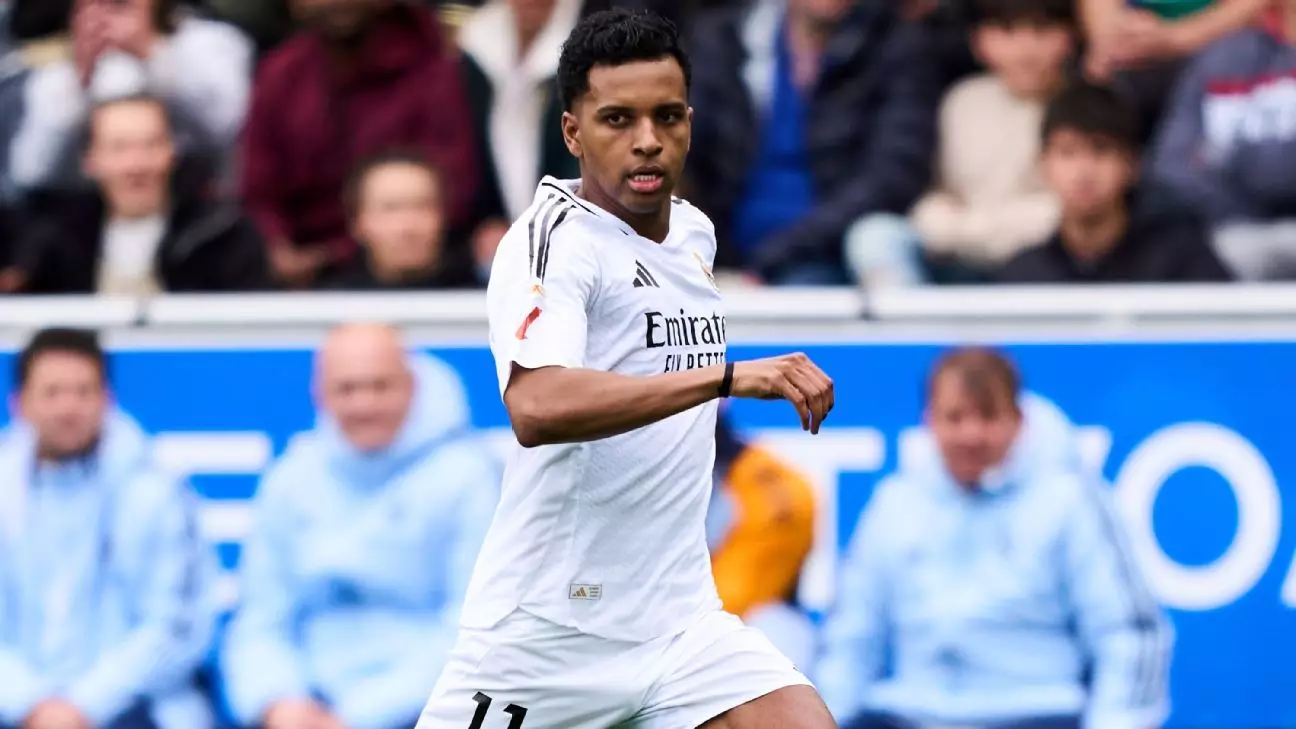Rodrygo Goes burst onto the scene as a prodigious talent at Real Madrid, quickly cementing his reputation with moments of brilliance that hinted at a future superstar. His standout performance against Manchester City in 2022, where he scored two goals within a mere 60 seconds, remains etched in the memory of football fans worldwide. That incredible feat contributed to one of the most legendary comebacks in the club’s illustrious history, heralding him as a growing star. However, the trajectory from rising star to underdog has been jarring and swift. What once looked like a bright future is clouded with doubt and controversy, illustrating how quickly fortunes in football can flip when technical and tactical shifts occur.
The club’s narrative insists that nothing has changed and that Rodrygo remains an integral part of their plans. Yet, beneath this veneer of reassurance, the reality presents a starkly different picture. His diminished playing time, particularly under the new coaching regime of Xabi Alonso, reveals a rift between narrative and reality. The Brazilian forward has been sidelined in crucial matches, including the Copa del Rey final and the Clásico—a sign that his role in Madrid’s future is questioned at best and dismissed at worst. The contrast between official statements and on-field reality signals a deeper, systemic issue that could redefine his career path.
The Strategic Shift and An Emerging Divide
The appointment of Xabi Alonso seemed initially promising for Rodrygo; however, strategic decisions by the coach point towards a preference for a different attacking blueprint. Alonso’s focus on a more streamlined two-striker system, coupled with the rise of Kylian Mbappé, Vinícius Júnior, and Jude Bellingham, has left little room for the 24-year-old to shine. His reduced involvement in key tournaments like the Club World Cup, with only a single start and no second-half appearances in crucial games, underscores his shrinking influence.
The tension within the club’s hierarchy adds another layer of complexity. While official channels suggest Rodrygo is still committed to Madrid, whispers from sources and intermediaries paint a different picture. There’s a growing sentiment among club officials to offload him, especially as they seek to bolster squad depth in defensive and midfield positions. The club’s reported willingness to listen to offers is a clear sign that his future is no longer in their hands alone. Their reluctance to drive negotiations openly could be strategic, aiming to keep options open until they find a partner willing to meet their valuation, which is reportedly around €80-100 million.
Meanwhile, Rodrygo’s camp has been inconsistent in their messaging. Publicly, he professes loyalty and a desire to remain at Madrid, but privately, whispers of dissatisfaction and requests for playing time have emerged. Such contradictions are symptomatic of a player caught between loyalty and ambition, facing the harsh reality that his role might be diminishing at the club he joined just five years ago.
The Market and Uncertain Destinations
In football, the transfer market often reveals as much about a player’s perceived value as it does about a club’s strategic priorities. Despite the fluidity of negotiations, no formal offers have materialized for Rodrygo, and Real Madrid stands firm on their valuation. Yet, rumors swirl, often based more on speculation than concrete interest, with outlets linking him to clubs across Europe and even the Middle East.
Most notably, Premier League clubs have shown tentative interest. Arsenal was initially linked with Rodrygo, but recent signings like Noni Madueke and Gyökeres appear to have cooled those prospects—mainly due to financial considerations. Bayern Munich’s earlier attempts to strengthen their attack have also faded, especially after their acquisition of Nico Williams and Luis Díaz, which shifted priorities elsewhere.
Liverpool is arguably the most plausible destination, especially given their recent losses and pursuit of attacking reinforcements. Nevertheless, obstacles remain, including the high valuation Madrid has placed on him. Considering the club’s financial demands, a transfer to a club like Liverpool might only be feasible if Madrid reduces their expectations or if Rodrygo himself insists on a move.
Other rumors, such as interests from Tottenham Hotspur or Saudi clubs, have been swiftly dismissed. Both the player and his agents seem to favor a move within the Premier League, where he could test himself at a higher level and possibly revive his fading prospects. Yet, with a month left in the transfer window, these potential paths remain speculative rather than imminent.
The Underlying Question: Is This a Crisis or Just a Crossroads?
Rodrygo’s current predicament highlights a larger issue faced by many young talents in top clubs: the challenge of translating early promise into sustained success amid changing team dynamics and tactical philosophies. It’s easy to oversimplify his decline as merely a loss of form or opportunity, but more telling is how quickly the football ecosystem can turn against even the most celebrated players.
The evolving narrative suggests that Rodrygo is at a pivotal point—either to fight for his place, which seems less likely given the current environment, or to accept a transfer that could reignite his career elsewhere. The player’s own attitude, fueled by frustration and a desire for consistent playing time, might ultimately push him toward a departure, even if Madrid continues to negotiate in the background.
The underlying lesson here isn’t just about one player’s career, but about how elite sports environments are unforgiving. Success in football isn’t guaranteed; it depends on a delicate blend of timing, tactical fit, and club confidence. For Rodrygo, the coming weeks will be definitive: will he adapt and redefine his role at Madrid, or will he become a cautionary tale of unfulfilled potential in the modern game?

